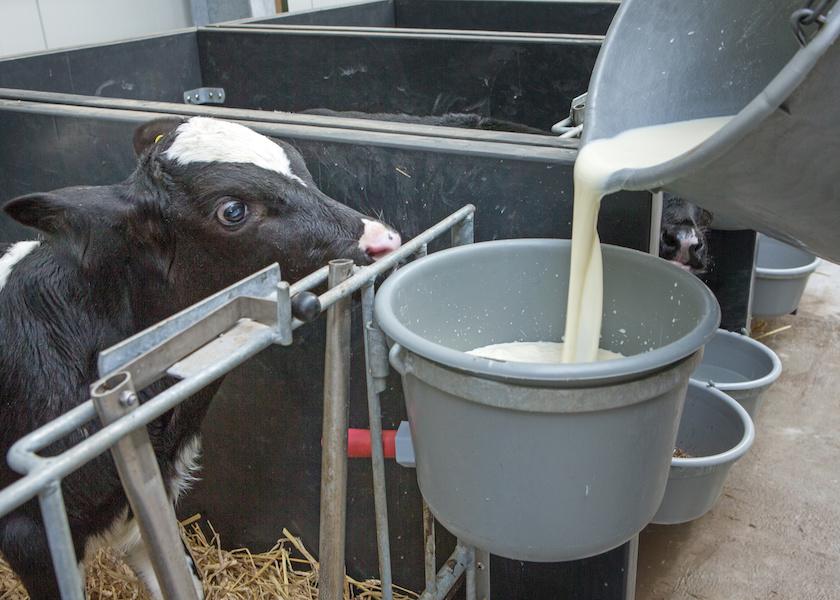Calf Milk Consistency Deserves Attention

Preweaned calves do best with consistency in every aspect of their lives – feeding time, housing temperature, ventilation, and – especially – the consistency of their liquid rations.
But the reality of daily calf rearing is that the feeding temperature and nutritional consistency of calf milk can vary quite a bit from feeding to feeding and day to day.
As an example, students in a dairy management class at Pennsylvania State University were assigned an experiment in mixing up a “standard” batch of milk replacer, with the results analyzed for final temperature and total solids content. Many of the 41 students were from dairy farms and had previous experience mixing milk replacer.
Each student was tasked with mixing 10 ounces of milk replacer powder with 2 quarts of warm water, with a goal of a final product containing 13% total solids and a feeding temperature of 110-115°F. They measured the milk replacer using the cup provided by the manufacturer.
Temperature of the final solution was measured with a thermometer, and solids content was evaluated using a Brix refractometer. Among the eye-opening results of the 41 batches:
- Solids content ranged from 6.0-14.5%
- Temperature ranged from 80-115°F.
- Less than half (17) batches achieved a solids content between 10 and 15%.
- Only 2 batches hit the solids content goal of precisely 13%.
- Only 2 batches achieved a final temperature between 110 and 115°F.
Penn State Dairy Extension advisors who summarized the findings noted that “standard” on-farm equipment of a plastic cup for powder, a pitcher or pail for water, and the calf feeder’s fingers for temperature, all can contribute to inconsistency. They suggested weighing powder with a scale; measuring temperature with a thermometer; and evaluating solids with a Brix refractometer will contribute to routinely creating batches of milk replacer with far greater precision.
Whole milk, too, can be highly variable in its nutritional content. Dr. Dale Moore at Washington State University conducted a hallmark study published in 2009 that evaluated nonsalable milk from 12 dairies supplying both milk and calves to one calf ranch.
Bacterial counts were deemed dangerously high from 9 of the 12 farms. While all of the milk was pasteurized at the calf ranch, pasteurization can only reduce bacterial load and does not completely sterilize milk.
Total solids also varied widely, from 5.1-13.5%. Half of the dairies shipped milk with total solids lower than 12.0%. When pooled at the calf ranch, total solids for the combined batch of milk were 11.0%, significantly lower than the expected 12.5-13.0% for whole milk.
Moore and her colleagues owed this variability to the fact that unsalable milk may come from newly fresh cows with higher solids in their milk; cows being treated in the hospital; and possibly the inadvertent addition of water from sanitation procedures. They suggested balancing whole milk with powdered solids before feeding to achieve consistent batches that reached nutrient content goals.
Feeding liquid rations with lower-than-desired solids – whether in the form of milk replacer or whole milk – can interfere with calf performance and health. Researchers with autofeeder manufacturer Holm & Laue point out that significant variation can occur simply between batches of milk replacer mixed to achieve a total volume, versus using that set volume of water and adding the powder to it.
For example, they said one liter of milk replacer solution containing 13.5% total solids would drop to 11.9% total solids if one liter of water was added to the equivalent amount of powder. The difference between the two: a surprising 12% lower energy and nutrient supply in the more dilute mixture.
That difference – and other inconsistencies evidenced in these two studies – underscore the importance of making liquid ration consistency a priority for calf raisers. Investing in the right equipment, protocol development, and training can make all the difference in delivering a consistent product to every calf, every day.
Holm & Laue also has prioritized consistency with a new feature on their CalfExpert automatic calf feeder. The Brix-TS Sensor is an electronic refractometer sensor that continuously measures the dry matter of freshly mixed calf milk. The autofeeder compensates for solids deficiencies in both milk replacer and whole milk, and can adjust for reduced powder dosing if powder outlets become encrusted.
The Brix-TS Sensor won a Silver EuroTier Innovation Award for new animal farming technology in 2021 in conjunction with the massive EuroTier animal agricultural trade show in Hanover, Germany.







